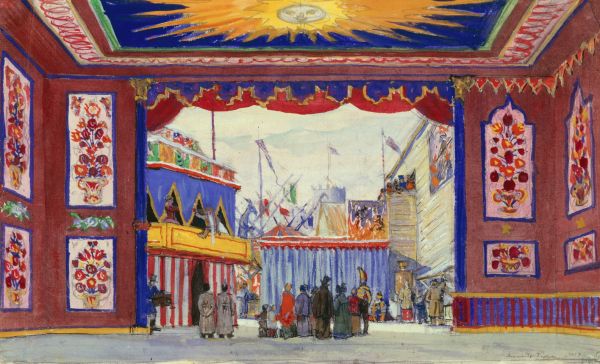|
|
Set design for Scene I. 1917

Benois Alexander,
Watercolour, gouache, Indian ink, quill and graphite pencil on paper
30,2 х 49,4
State Russian Museum
Пост. в 1921 из Общества поощрения художеств, Петроград
Annotation
Petrouchka was created jointly by Alexander Benois, the composer Igor Stravinsky and the choreographer Michel Fokine for Sergei Diaghilev’s third Saison Russe in Paris in 1911. In 1920, Petrouchka was staged at the Mariinsky Theatre, based on revived designs of 1917–1918. The stage sets consisted of a portal and four interchanging tableaux inbetween. The first and final tableaux depict the merry shrovetide festivities on a snow-covered square in St Petersburg of the 1830s–1840s. As Benois wrote, “I was ... tempted by the idea of depicting the Butter Week Fair ...the dear balagani [fairground booths] which were the delight of my childhood.” When working on the costumes for Petrouchka, Benois closely studied historical and genre material — folk toys, Russian popular prints, lithographed albums and fashion journals of the 19th century. The plot of the ballet is the rivalry of Pétrouchka, “a grotesque, half-human being”, and Blackamoor for the attention of the Ballerina. Benois lends the hero of his design the movement, gesture and mimics of the future performer, Vaslav Nijinsky, who succeeded, in Benois’ words, in “expressing Pétrouchka’s pitiful oppression and hopeless efforts to achieve personal dignity, without ever ceasing to be a puppet.”
Author's Biography
Benois Alexander
Benois, Alexander Nikolaevich
1870, St Petersburg - 1960, Paris
Graphic artist, painter, theatrical designer, art historian. Studied under brother Albert Benois, at the Imperial Academy of Arts (1887-1888) and at the Faculty of Law, St Petersburg University (1890-1894). Member of the World of Art (1899; founding member), Union of Russian Artists (1903) and the Salon d'Automne (1906). Contributed to the exhibitions of the Society of Russian Watercolourists (1891-1896), Sergei Makovsky Salon (1909), International Exhibitions in Munich (1898), Rome (1911), Malmo (1914) and the Exhibitions of Russian Art in Paris (1906, 1910) and Berlin (1906). Designed for the Mariinsky Theatre, Vera Komissarzhevskaya Theatre and the Starinny Theatre in St Petersburg, Moscow Arts Theatre, Sergei Diaghilev's Ballets Russes, Ida Rubinstein Ballet Company, Teatro Real de Madrid, Theatre des Champs Elysees and Theatre National de L'Opera in Paris. Curator of the Hermitage Picture Gallery (1918-1926). Member of the Commission for the Protection of Monuments of Art and Antiques. Edited the Art Treasures of Russia magazine (1901-1903). Emigrated to Paris (1926).

